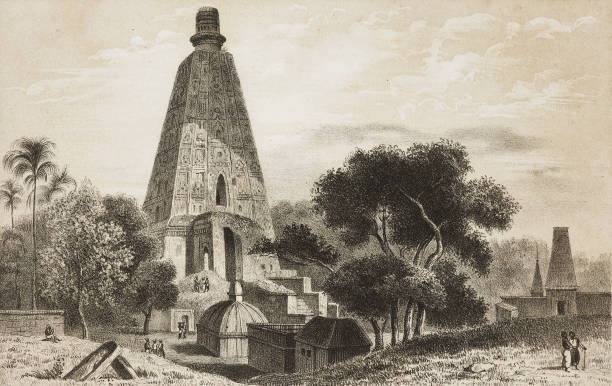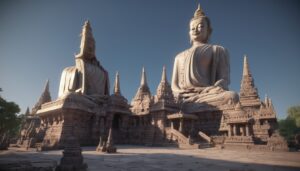Lord Buddha, also known as Siddhartha Gautam, was an incarnation of compassion, and lakhs of people flocked to the Mahabodhi Temple Complex in Bodh Gaya 2500 years after his birth. Lord Buddha’s allure is so strong that you can feel it even at the location of his Enlightenment.

The Mahabodhi Temple complex is a lovely spot where monks congregate to chant and meditate at the feet of a massive Buddha statue. Tourists congregate to pay homage to the magnificent soul that walked among us in flesh and blood to enlighten humanity. Many people visit Bodh Gaya, especially around Buddha Poornima, which falls at the end of April or May every year.
Table of Contents
History Of Mahabodhi Temple
There are four significant temples associates with the Buddha’s life at various stages. One of the most important is the Mahabodhi Temple. Some of the people said that it was here that the Buddha sat and meditated under a fig tree before obtaining Enlightenment and becoming the Buddha.
This spot is essentially where Buddhist doctrines and beliefs were born. Buddhists believe that this location is also the universe’s hub. It is the only location capable of bearing such spiritual weight: it will be the last site to be destroyed at the end of time and the first to be reborn in the new world.

Buddha claimed to have attained Enlightenment in the 6th century BCE. Therefore the location was essentially naked for several centuries until Ashoka arrived. Between 260 and 250 BCE, the emperor visited the location and the pilgrimage town of Bodh Gaya and chose to build a temple and monastery in honor of the Buddha.
The Diamond Throne, an elevated platform, claimed to mark the particular site where the Buddha sat when he attained Enlightenment. He built it the first thing. The site also has several stupas (Buddhist mound-shaped temples).
Architecture Of Mahabodhi Temple

Bodhgaya is the most important Buddhist pilgrammage destination in the world and one of the most engaging of holy sites associated with Buddha’s life. Buddha was born Siddartha Gautama in 563 B.C. near the present day border of India and Nepal. Buddha denounced all of his earthly possessions and on his path to Enlightenment, spent 6 years meditating on life’s excesses in a cave near Bodhgaya.
Following his disappointment with asceticism, he took a ‘middle path’ of less extreme practices and formulated his philosophy of a balanced approach to life. After spending close to a week in meditation underneath the Bodhi tree, he came to realize his true nature and that of reality. A sapling of the Bodhi Tree was taken to Sri Lanka from which a cutting came back to Bodhgaya which stands now next to a Buddhist temple built by Emperor Ashoka in the 3rd century B.C. The current temple was restored in the 11th century and again in 1882. There is a constant flow of pilgrims from all religions. (Photo by Robert Nickelsberg/Getty Images)
What you see today at the Mahabodhi Temple, on the other hand, is from a different age. In the 5th and 6th centuries CE, Indian emperors of the Gupta Empire restored the site. It is when the colossal temples that now define Mahabodhi were constructed. They constructed it in the Gupta style of Indian architecture (not a Buddhist style). They knew for their excellent brickwork.
The temples are ornately decorated and ornamented in the Gupta style, with many sculptures of Buddhist figures, reliefs and carvings of Buddhist (and some Hindu) scenes, and other Buddhist symbols. Lotus blooms, a sign of purity and detachment, adorn the location in abundance.
The Mahabodhi Temple fell into decay after the 12th century CE. In India, Islamic interests posed a danger to Buddhism. And they abandoned temple site. It was later renovated in the nineteenth century and brought back to its previous glory. This Temple is still one of Buddhism’s most sacred locations. It is also a tribute to India’s architectural and cultural legacy today.
Decline Of Mahabodhi Temple

Following the White Hun and early Islamic conquests, such as Muhammad bin Qasim’s, Buddhism fell as the dynasties that patronized it crumbled. The Pala Empire saw a remarkable rebirth (where the temple stands). Between the ninth and twelfth centuries, Mahayana Buddhism flourished under the Palas.
Following the fall of Palas by the Hindu Sena dynasty, Buddhism’s standing in India began to decline once more until it became practically extinct. Muslim forces raided Bodh Gaya and the surrounding areas in the twelfth century C.E. The Mahabodhi Temple was mostly abandoned and fell into disrepair.
Hindus founded a monastery at Bodh Gaya in the fifteenth century. The monastery’s abbot, or mahant, became the area’s major landholder over the ages, claiming possession of the Mahabodhi Temple grounds.
Restoration Of Mahabodhi Temple
Under the guidance of Sir Alexander Cunningham, the British administration of India began to renovate Mahabodhi Temple in the 1880s. Shortly after, in 1891, the Sri Lankan Buddhist leader Anagarika Dharmapala began a campaign to reclaim ownership of the temple from the mahant, despite the mahant’s objections.
After a somewhat successful campaign in 1949, Hindu Mahant transferred control of the temple to the Bihar state government, which established a temple management committee.
The committee includes nine members, most of whom must be Hindus by law, including the chairperson. Under the management committee, Anagarika Munindra, a Bengali man who had been an active member of the Maha Bodhi Society, became Mahabodhi’s first head monk.
Some Interesting Facts About Mahabodhi Temple Complex
- It is thought that Gautam Buddha acquired Enlightenment in this location. After three days and three nights of meditation under a peepal tree, young prince Siddhartha (who eventually became Gautam Buddha) received all of the answers he sought.
- The Mahabodhi Temple complex, established by Emperor Ashoka in 260 BC. It is one of the first Buddhist temples to be constructed completely of brick. Its architecture has been extensively praised as one of eastern India’s oldest brick constructions.
- In June 2002, the temple complex was designated a UNESCO World Heritage Site. All of its religious treasures have been legally safeguarded since then.
- The Mahabodhi temple’s central tower is approximately 55 meters tall. It repaired numerous times throughout the nineteenth century. It is encircled by four lesser towers.
- Aside from the magnificent statue, the temple complex includes the Bodhi Tree (a descendent of the tree beneath which Buddha attained Enlightenment), the lotus pond, and other historic stupas that interest Buddha enthusiasts. These locations links to the seven weeks that Buddha is claimed to have spent in this location.
The Story Of Buddha Statue

The temple’s initial statue was supposed to be a one-breasted Buddha statue. Legend has it that a traveler pledged to make the best statue in the world if it met three criteria. He requested that the shrine be filled with fragrant clay and a candle and asked that the door be shut for six months.
He also asked that no one bother him for the next six months. People, however, became impatient and shattered the door just four days before the six-month mark. They discovered an unfinished statue that was flawless in every way (one breast). There was no sign of the traveler. Later, a monk sees Lord Maitreya erecting the statue on his own.
The Descendent Of The Original Bodhi Tree Is Inside The Temple

Are you aware that the temple houses the Bodhi tree, where Buddha attained enlightenment? It’s only half-true. After completing the temple, Emperor Ashoka sent his heirs to Sri Lanka and other parts of India to promote Buddhism. He also gave a sapling of the original tree to Sri Lanka.
When Muslim invaders damaged the temple and the original tree, a sapling from the Sri Lankan tree carried back to Mahabodhi and planted. The tree’s strength, on the other hand, is eroding.
The tree is slowly slanting and gaining support from the temple walls. It could cause major damage to the temple. Therefore when the tree falls, people prepare to replace it with a clone. Make sure to pay a visit while the tree is still standing.
Protection And Management Requirements

The Bihar State Government owns the Mahabodhi Temple Complex. Through the Bodhgaya Temple Maintenance Committee (BTMC) and Advisory Board, the State Government is responsible for the management and protection of the property under the Bodh Gaya Temple Act of 1949.
The Committee meets every three or four months to examine the status of the property’s maintenance and conservation projects and control the flow of pilgrims and tourists. The Committee has 85 full-time employees and over 45 part-time employees. They assist the Temple with office personnel, security guards, gardeners, and sweepers.
The norms and regulations of the Site Management Plan created by the Government of Bihar govern all development activities inside this World Heritage property and in Bodhgaya. Under the technical guidance of the Archaeological Survey of India, all conservation and restoration work on the Temple Complex.
The property’s primary source of funding comes through Devotee donations. They can effectively maintains the temple complex. And they can adequately handle the flow of visitors thanks to the management system’s continued operation.
Many pilgrims/tourists (national/international) visit this pilgrimage site Mahabodhi Temple. There is necessity the development of infrastructure and public amenities. The Bodhgaya Temple Management Committee also aspires to take a long-term strategy to property management. For example using solar energy and maintaining a pollution-free environment.
Also Read: GAYA TO PATNA TRAIN | IMPORTANT TRAINS


